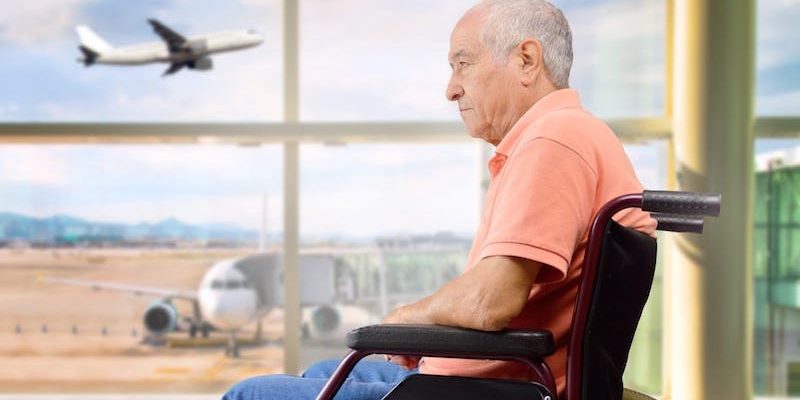Even though going on vacation can be a lot of fun, air travel can be extremely stressful.
In fact, 73% of Americans believe they are travel cursed due to stressful experiences they’ve had involving air travel.
However, as stressful as air travel is for the average American, it can be even more stressful if you need to travel by wheelchair.
Not to worry though, while flying with a wheelchair can add some extra stress, it doesn’t have to be that way.
Check out this guide to learn some great air travel tips when flying with a wheelchair.
Before the Flight
A lot of the planning for traveling with a wheelchair will happen before you even get on the flight.
Some airlines allow you to notify them that you will be traveling with a wheelchair as you are booking, while others require you to make a phone call after your reservation is confirmed.
Either way, it’s usually best to give the airline a call so you can have a clear understanding of their policies and procedures regarding wheelchairs, and so you can get all of your questions answered.
When informing the airline about your wheelchair, you should let them know the following details:
- Exactly what kind of assistance you’ll be needing
- Whether your wheelchair is electric or manual
- If it is a manual, inform them of the dimensions, and whether or not it can fold
- If it’s an electric chair, let them know the weight of it and what type of batteries it needs
Also, when booking your flight, keep these general tips in mind:
- If possible, book an aisle seat near the front of the plane
- If possible, book a direct flight. This eliminates the hassle of boarding and exiting two times
- Know how you’re going to transfer into your seat. If necessary, pack transfer straps and a transfer board.
- Take a picture of your equipment beforehand in the event that any damage is incurred during your air travel
Know Your SSR Code
SSR stands for Special Service Request. If you are traveling with a wheelchair, and need any sort of assistance, you will need to have an SSR code attached to your reservation.
In order to do this, you will need to call the airline and inform them of the type of assistance you need.
Here are the different SSR codes for wheelchair assistance:
- WCHR: Required wheelchair assistance; you can walk a short distance up or down the stairs
- WCHS: Requires wheelchair assistance; unable to walk a short distance up or down the stairs
- WCHC: Requires wheelchair; passenger is unable to walk any sort of distance and will need the wheelchair to board
- WCOB: Passenger will need a wheelchair for on-board use
- WCMP: Traveling with a manual wheelchair
- WCBD: Traveling with a wheelchair that is dry-cell battery-powered
- WCBW: Traveling with a wheelchair that is wet-cell battery-powered
There are also SSR codes for other disabilities, so keep that in mind if you have anything else, you need to let the airline know about.
Packing
Packing is obviously going to differ a lot from one individual to the next. However, there are some general guidelines you’ll want to keep in mind.
First things first, keep in mind that airline baggage policies vary greatly. They can also vary within the airline depending on what type of ticket you buy (economy, business class, first class, etc.).
Some things you’ll want to keep in mind include:
- Some airlines do not charge for extra baggage when packing medical supplies separately. Check with your airline to learn their policy.
- In your carry on, you will want to pack easy-to-access medical supplies, medication, and any tools needed for your wheelchair. This is crucial in the event that there is a canceled or delayed flight, or that your luggage gets lost
Arriving at the Airport
 Once you arrive at the airport, you will check-in as you normally would.
Once you arrive at the airport, you will check-in as you normally would.
Also, depending on the airport, you may need to check your wheelchair prior to going through the security line. If this is the case, the airport will provide you with a terminal wheelchair and an attendant to assist you with the rest.
Once you are at your gate, speak to the airline representative about pre-boarding. Once the pre-boarding process begins, you will make your way into the plane, at which point you will need to be transferred to an aisle-sized wheelchair.
If you’ve been able to keep your normal wheelchair up until this point, be sure to remove and protect any sensitive electronics.
Also, remember to bring your seating cushion to use in-flight.
During the Flight
The actual flight is usually the easiest part of traveling with a wheelchair. However, some complications can arise.
For example, your bathroom options might be limited. Some airlines might be able to transport you to the bathroom using the aisle wheelchair; however, this isn’t always the case.
If you have a utilized catheter or an adult incontinence product, it’s a smart idea to bring that along. Also, try to limit your fluid intake so you can avoid the bathroom issue altogether.
Arrival
Once you arrive at your destination, you will need to wait until the other passengers disembark the plane.
Once this is done, you will have an attendant bring you a terminal wheelchair and escort you off the plane.
At this point, you will proceed to baggage claim where you will be able to find your personal wheelchair.
Air Travel Tips: Are You Ready for Traveling with Your Wheelchair?
As you can see, there’s a lot to keep in mind when traveling with a wheelchair. However, it will get easier and easier every time as you figure out your routine.
Be sure to check out our product page if you are in need of a new wheelchair.

